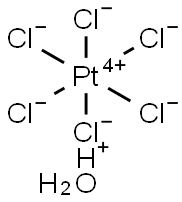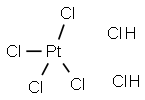A2413112
Chloroplatinic acid hexahydrate , ACS,Pt37.5%min , 18497-13-7
Synonym(s):
Hexachloroplatinic acid hexahydrate;Hydrogen hexachloroplatinate(IV) hexahydrate;Platinic chloride hexahydrate
CAS NO.:18497-13-7
Empirical Formula: Cl6H3OPt-
Molecular Weight: 426.81
MDL number: MFCD00149910
EINECS: 629-612-1
| Pack Size | Price | Stock | Quantity |
| 200mg | RMB159.20 | In Stock |
|
| 1G | RMB472.00 | In Stock |
|
| 5G | RMB2072.00 | In Stock |
|
| others | Enquire |
Update time: 2022-07-08
PRODUCT Properties
| Melting point: | 60 °C |
| Density | 2.430 |
| storage temp. | room temp |
| solubility | H2O: soluble0.5M, clear, orange |
| form | Solid Powder |
| color | orange |
| Water Solubility | Soluble in water, ethanol, ether, ethyl acetate and acetone. Insoluble in nitric acid. |
| Sensitive | Hygroscopic |
| Exposure limits | ACGIH: TWA 0.002 mg/m3 NIOSH: IDLH 4 mg/m3; TWA 0.002 mg/m3 |
| Stability: | Hygroscopic |
| InChI | InChI=1S/6ClH.H2O.Pt/h6*1H;1H2;/q;;;;;;;+4/p-5 |
| InChIKey | KVERJCFPWMYIII-UHFFFAOYSA-J |
| SMILES | [Pt+4]([Cl-])([Cl-])([Cl-])([Cl-])([Cl-])[Cl-].[H+].O |
| CAS DataBase Reference | 18497-13-7(CAS DataBase Reference) |
| EPA Substance Registry System | Platinate(2-), hexachloro-, dihydrogen, hexahydrate, (OC-6-11)- (18497-13-7) |
Description and Uses
Dihydrogen hexachloroplatinate(IV) hexahydrate is used for the determination of potassium. It is also used for the purification of platinum by treating it with ammonium chloride flowed by heating of ammonium hexachloroplatinate with hydrogen yields elemental platinum. It also finds application in catalysis, electroplating, photography, platinum mirrors, printing for etching of zinc, producing fine color in glass and porcelain, indelible ink and microscopy. It is a precursor for the preparation of other platinum catalysts.
Safety
| Symbol(GHS) |    GHS05,GHS06,GHS08 |
| Signal word | Danger |
| Hazard statements | H301-H314-H317-H334 |
| Precautionary statements | P260-P270-P280-P303+P361+P353-P304+P340+P310-P305+P351+P338 |
| Hazard Codes | T |
| Risk Statements | 42/43-34-25 |
| Safety Statements | 45-36/37/39-26-22 |
| RIDADR | UN 2507 8/PG 3 |
| WGK Germany | 1 |
| RTECS | TP1510000 |
| TSCA | Yes |
| HazardClass | 8 |
| PackingGroup | III |
| HS Code | 28439000 |
| Toxicity | mouse,LD50,intraperitoneal,82mg/kg (82mg/kg),Toxicology and Applied Pharmacology. Vol. 49, Pg. 41, 1979. |



